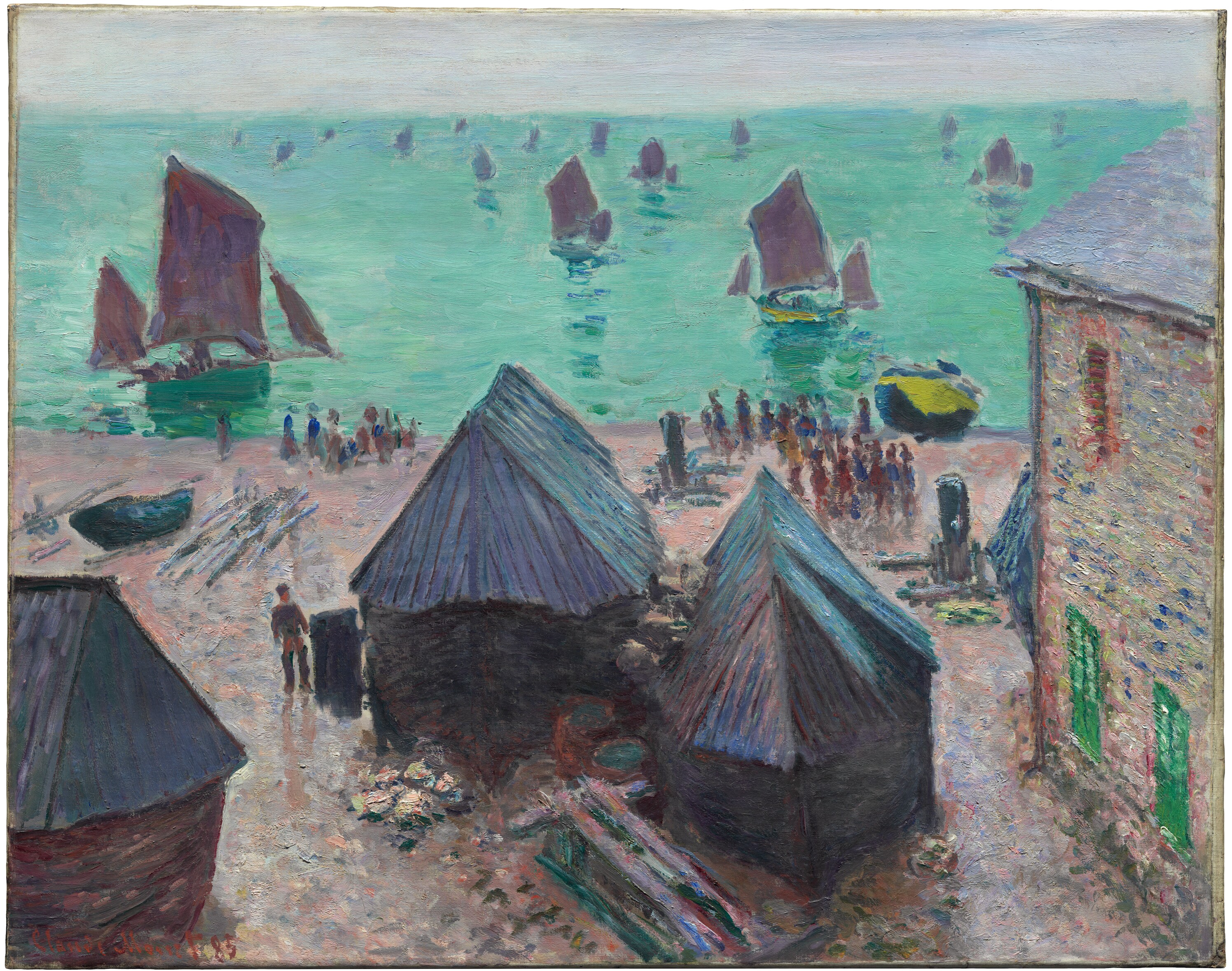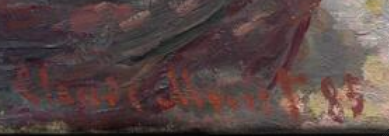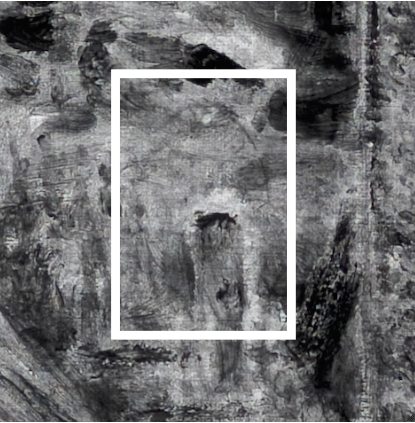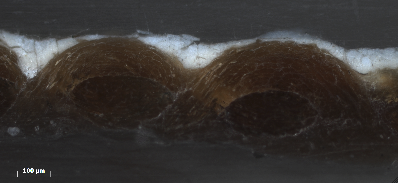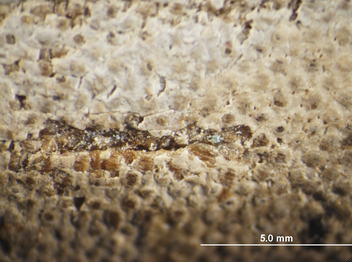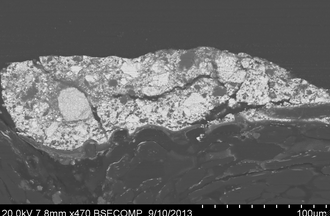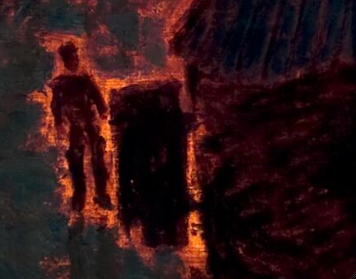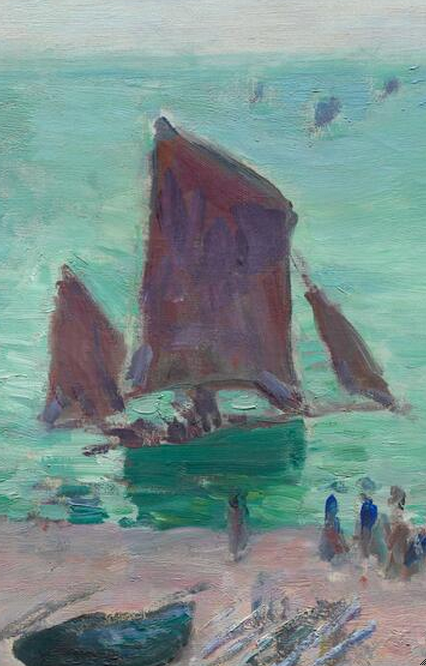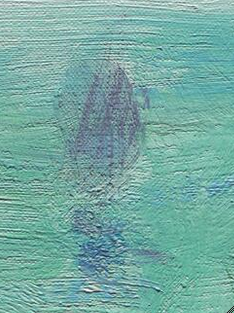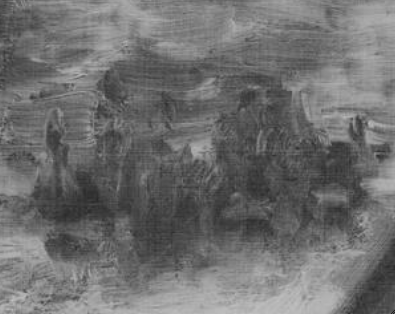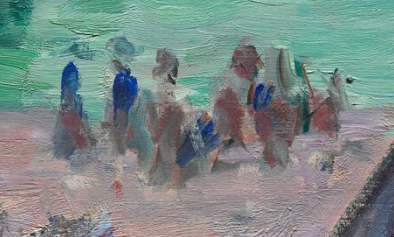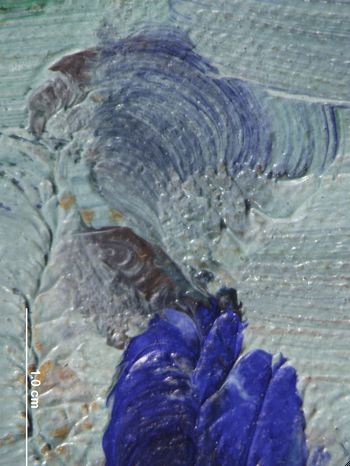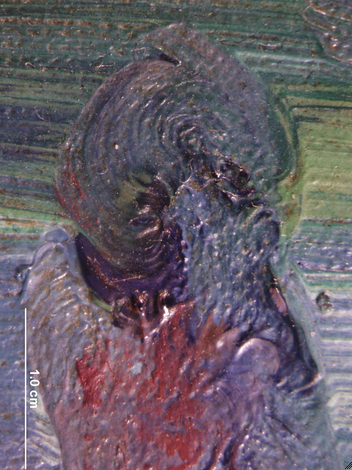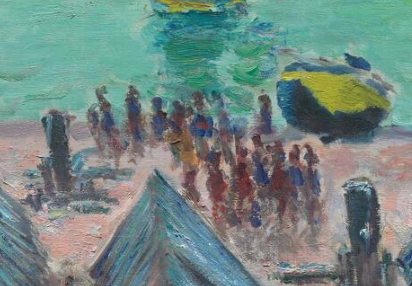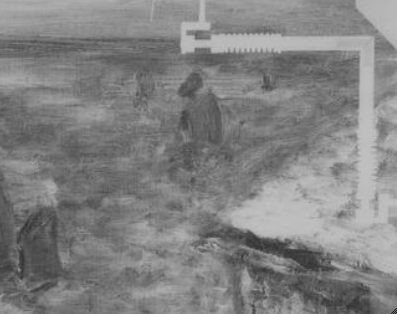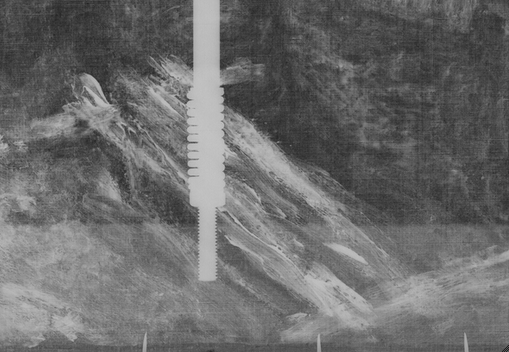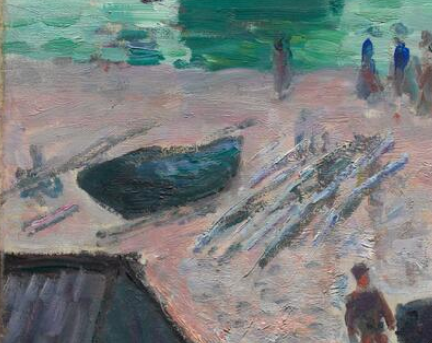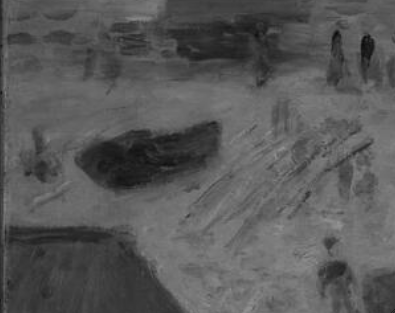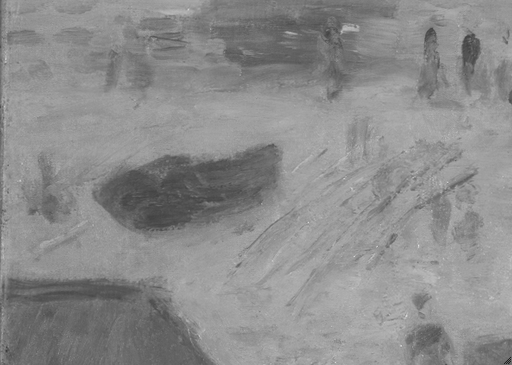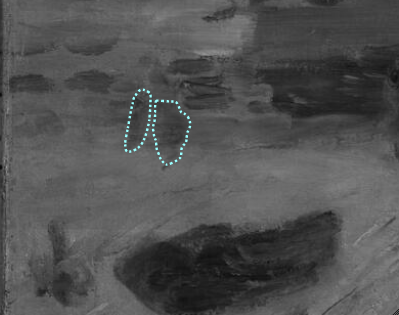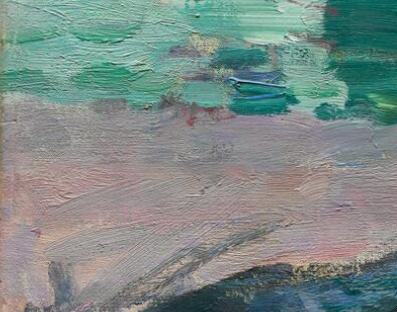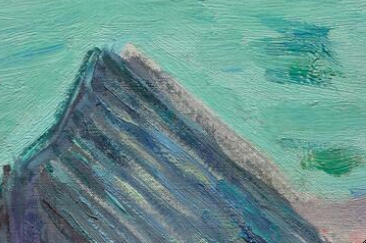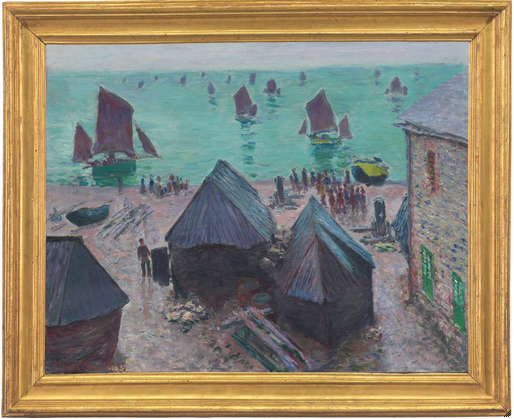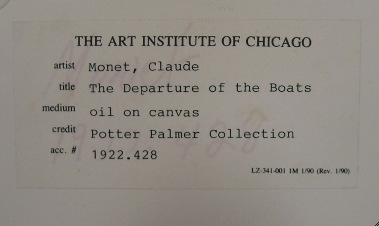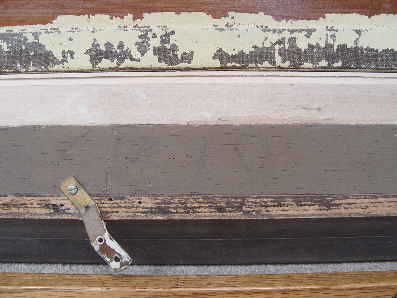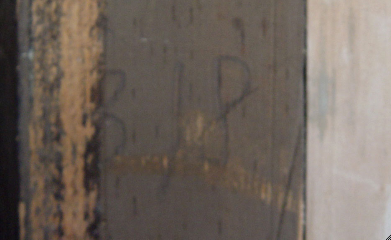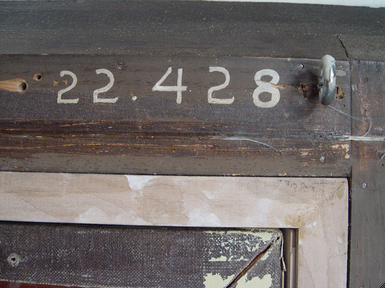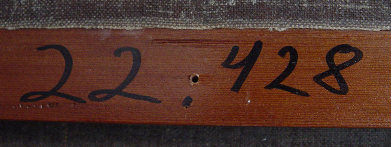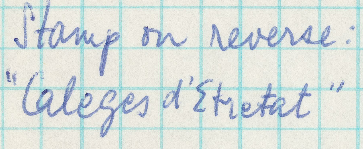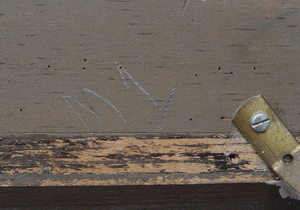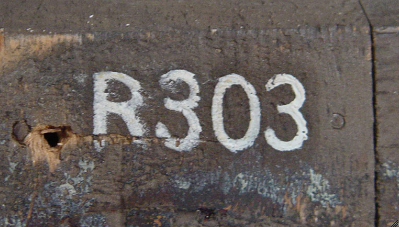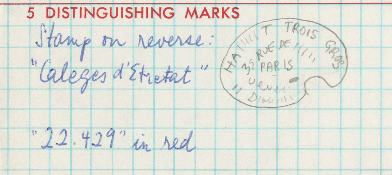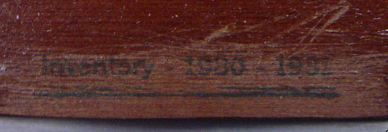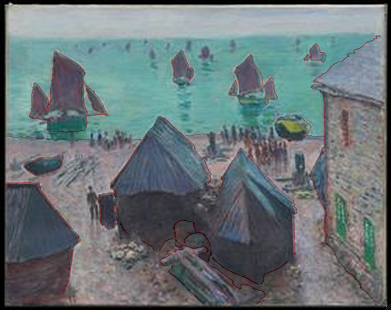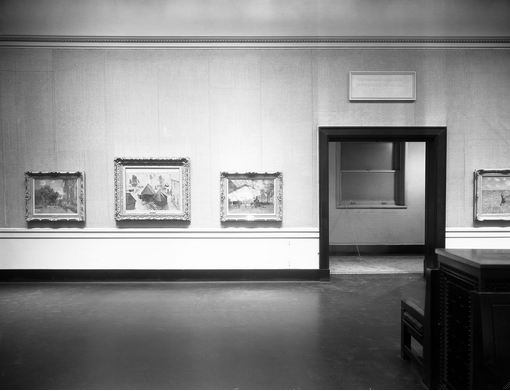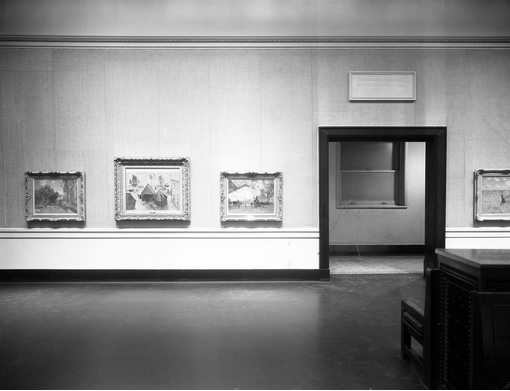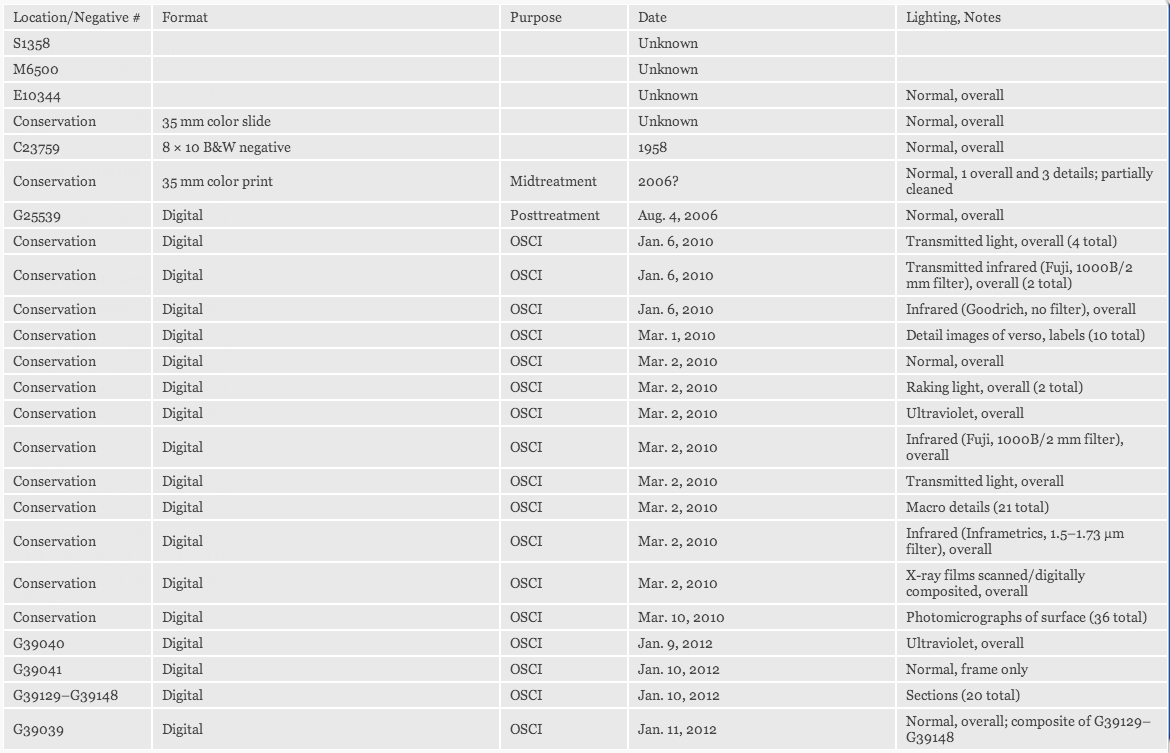Cat. 23
The Departure of the Boats, Étretat
1885
Oil on canvas; 73.5 × 93 cm (28 15/16 × 36 19/16 in.)
Signed and dated: Claude Monet 85 (lower left corner, name in orange-red paint, year in reddish-brown paint)
The Art Institute of Chicago, Potter Palmer Collection, 1922.428
Technical Report
Technical Summary
Claude Monet’s Departure of the Boats, Étretat was painted on a pre-primed, no. 30 portrait (figure) standard-size linen canvas. The ground is off-white and consists of a single layer. There is a stamp from the color merchant Vieille & Troisgros on the original canvas back. The canvas weave exhibits a warp-thread match with Monet’s Étretat: The Beach and the Falaise d’Amont ([W1012], inv. 1964.204) (cat. 21) and Rocks at Port-Goulphar, Belle-Île ([W1095], inv. 1964.210) (cat. 24), suggesting that the fabric for these paintings came from the same bolt of material. The composition was built up with little deviation from the initial lay-in. It was carried out in several sessions, with a large degree of wet-in-wet paint application in the upper layers. Technical examination revealed some minor revisions including painted-out forms on the left side of the beach, possibly related to the fishing accoutrements, the painting out of what may have been a second window on the upper floor of the stone building, and the addition of some figures to the crowd of people on the right side of the work.
Multilayer Interactive Image Viewer
The multilayer interactive image viewer is designed to facilitate the viewer’s exploration and comparison of the technical images (fig. 23.1).
Signature
Signed and dated: Claude Monet 85 (lower left corner, name in orange-red paint, year in reddish-brown paint) (fig. 23.2). The signature and date appear to have been applied at the same time, when the paint layers beneath were already dry.
Structure and Technique
Support
Canvas
Flax (commonly known as linen).
Standard format
The original dimensions were approximately 73.3 × 92.5 cm. This corresponds closely to a no. 30 portrait (figure) standard-size canvas (92 × 73 cm), turned horizontally.
Weave
Plain weave. Average thread count (standard deviation): 26.9H (0.8) × 28.5V (0.7) threads/cm. The vertical threads were determined to correspond to the warp and the horizontal threads to the weft. A warp-thread match was found with Étretat: The Beach and the Falaise d’Amont (cat. 21 [W1012], inv. 1964.204) (cat. 21) and Rocks at Port-Goulphar, Belle-Île (cat. 24 [W1095], inv. 1964.210) (cat. 24).
Canvas characteristics
There is relatively even cusping around all four edges. The cusping is stronger on the left and right sides.
Stretching
Current stretching: The current stretching dates to the 1962 conservation treatment; copper tacks spaced approximately 7–8 cm apart (see Conservation History).
Original stretching: Tack holes, spaced approximately 5–7.5 cm apart, correspond to cusping in the canvas.
Stretcher/strainer
Current stretcher: ICA spring stretcher. Depth: 2.5 cm.
Original stretcher: Discarded. The pre-1962-treatment stretcher may have been the original stretcher. According to the 1962 examination report, the previous stretcher was a five-membered stretcher with a vertical crossbar. Depth: Based on the presence of an additional crease in the tacking edge fabric, presumably where excess canvas was folded over the back edge of the stretcher, the original stretcher depth would have been approximately 1.8 cm.
Manufacturer’s/ supplier’s marks
A supplier’s stamp on the back of the canvas was transcribed before the painting was wax-resin lined in 1962 (see Conservation History) (text within palette-shaped frame):
HA [sic] . . . T TROIS GROS [sic] / 39 [sic] RUE DE . . . / PARIS / . . . / . . . (fig. 23.3)
Only a faint trace of the canvas stamp was visible in transmitted infrared (fig. 23.4).
Preparatory Layers
Sizing
Not determined (probably glue).
Ground application/texture
There is a single ground layer. It extends to the edges of all four tacking margins, indicating that the canvas was cut from a larger piece of primed fabric, which was probably commercially prepared. The ground layer ranges from approximately 15 to 115 µm in thickness (fig. 23.5). Some tiny bubble holes were observed in the ground layer where it was exposed at the edges of the painting.
Color
Off-white; under magnification, some dark particles are visible (fig. 23.6).
Materials/composition
Analysis indicates that the ground contains primarily lead white and calcium carbonate (chalk), with traces of bone black, iron oxide with associated silicates, alumina, aluminum silicate, and silica. Both the lead white and the chalk exhibit particles and clusters of various sizes (fig. 23.7). Binder: Oil (estimated).
Compositional Planning/Underdrawing/Painted Sketch
Extent/character
No underdrawing was observed with infrared reflectography (IRR) or microscopic examination.
Paint Layer
Application/technique and artist’s revision
The main compositional elements—the three caloges, the stone building, the winches, most of the figures, and the boats—were incorporated into the composition early on, either painted directly over the ground layer or wet-in-wet into the first underpainting layer. The beach and the water were then built up around them (fig. 23.8). A border of exposed or thinly painted ground often remains at the edges of the forms (fig. 23.9). This is evident around the sails and some of the figures, particularly around the foreground figure and the open caloge door (fig. 23.10). It looks as if the larger sailboats were articulated with quick strokes of the brush in pale purplish-gray paint. The water was then brought up around the boats, the sails were reinforced using slightly more intense colors, and then the reflections were added in the water (fig. 23.11). Some of the smaller sailboats in the distance were succinctly indicated with a quick brushstroke into the wet underpainting layer of the water; the water was then built up and a final stroke was applied overtop to indicate the sail when the paint from the water was already surface dry (fig. 23.12).
As the painting progressed, the artist moved back and forth between the compositional elements and the background, building up the forms and reinforcing the contours. This can be seen, for example, in the group of figures on the left shoreline. The group was roughly laid in early on, as evidenced by the relative radio-transparency of this area of the painting (fig. 23.13), as well as by glimpses of the thin reddish and bluish-gray paint that was used to lay in the general forms of the figures directly over the ground layer (fig. 23.14). The water was then built up with the thick, horizontal strokes of pale bluish-green paint, and the individual figures were painted wet-in-wet on top (fig. 23.15). The figures themselves were composed with quick gestural strokes, often consisting of incompletely mixed color, with touches of more intense local color applied on top (fig. 23.16). The pinkish-gray paint of the beach was then added, coming up over the figures in places. The group of figures on the right side of the painting seems to have been planned from early on, as some of the figures were painted directly over the ground layer, which remains exposed in between brushstrokes (fig. 23.17). Other figures from the group on the right were added wet-in-wet over the water (in the case of the figures on the far left) and over the dry paint of the beach (the figures at the lower center of the group), indicating that the group was expanded as the painting developed.
Technical imaging has revealed a few minor revisions to the painting. In the upper half of the stone building, there is a broad, radio-opaque, vertical stroke near the right edge (fig. 23.18). Although the paint here is handled differently from the way the other windows of this building were composed, the size, shape, and placement of the strong vertical stroke seems to echo that of the other extant windows, perhaps suggesting that a second upper-story window was planned and then subsequently blocked out with the vertical stroke. In the water, just above the building, two relatively radio-transparent areas in the X-ray suggest that either the small, three-sailed boat was originally laid in slightly to the upper left of its current position or that one or two smaller boats were planned (fig. 23.19). A small modification was also made to the discarded winch in the foreground. The X-ray shows that the winch was laid in at a slightly different angle compared to the final painting (fig. 23.20). Some possible revisions on the left shore are revealed with the aid of infrared reflectography. Between the small boat and the caloge, there are three or four vertical forms that have been partially covered by paint from the beach and the diagonal poles. Traces of the underlying paint related to these vertical features remain visible on the surface (fig. 23.21), becoming slightly more discernible in the infrared image (fig. 23.22). It is unclear whether these are props raising the ends of the poles off the ground, or whether they could possibly have been conceived as figures (the form on the far right, which is roughly circular at the top, looks similar to how some of the distant figures were rendered) (fig. 23.23). On the shoreline near the left edge, another form is visible in the infrared reflectogram (fig. 23.24). Reddish-brown paint from this underlying form can also be seen through breaks in the brushwork of the beach and the water, applied on top (fig. 23.25). It is not clear what this form may have represented. Other minor adjustments were made to the contours of forms as the painting was built up; for example, on the middle caloge, the back peak of the roof seems to have been shifted slightly to the left, between the initial planning and the final painting (fig. 23.26).
Painting tools
Brushes, including 1.0 and 1.5 cm width, flat ferrule (based on width and shape of brushstrokes). There are a few brush hairs embedded in the paint layer.
Palette
Analysis indicates the presence of the following pigments: lead white, cadmium yellow, chrome yellow, vermilion, red lake, viridian, emerald green, cobalt blue, and ultramarine blue. UV fluorescence of some of the red strokes indicates the use of red lake throughout the painting, except in the water. Cross-sectional analysis reveals that Monet sometimes used surprisingly complex pigment mixtures; for example, the dull gray caloge roof contains a mixture of several brightly colored pigments (fig. 23.27).
Binding media
Oil (estimated).
Surface Finish
Varnish layer/media
The painting was cleaned in 2006 and left unvarnished (see Conservation History).
Conservation History
The painting was cleaned and varnished in 1922.
In 1962, discolored varnish was removed. A spray coat of polyvinyl acetate (PVA) AYAA was applied, followed by a final spray coat of methacrylate resin L-46. The previous lining was removed. The canvas was wax-resin lined and restretched on a new ICA spring stretcher.
In 2006, the synthetic varnish applied in 1962, as well as older, yellowed, natural-resin varnish residues, were removed. A few tiny spots were inpainted. The surface was left unvarnished.
In 2007, a small fragment of original canvas that had come loose from the lining canvas was readhered.
Condition Summary
The painting is in good condition. The canvas is wax-resin lined and stretched taut on an ICA spring stretcher. The tacking margins show some wear and abrasion from handling. The ground and paint layers are secure with only a few tiny losses near the edges and minimal retouching. There are a few brush hairs embedded in the paint layer. Some flattening of the paint around the edges appears to be the result of framing while the paint was still soft. There is a network of fine cracks (visible, for the most part, only under magnification) with more pronounced cracking in areas of thick paint application. The surface is currently unvarnished, although there are microscopic residues of yellowed varnish in the recesses of the paint texture.
Kimberley Muir
Frame
Current frame (installed by 2011): The frame is not original to the painting. It is an Italian, eighteenth-century, Salvator Rosa, plain-molded, scotia frame with ogee back and stepped ogee sight molding. The frame is water gilded over thin yellow bole on gesso. The convex top molding is burnished, with all other areas matte. The scotia sides and back flat edge are painted in yellow ocher. The original glue size is retained throughout. The frame is made of poplar with applied mitered back, front, and sight moldings on a half-lapped cassetta base. The molding, from perimeter to interior, is ogee; scotia side; convex face with treacle back edge; stepped fillet; scotia; ogee; torus; stepped ogee; and cove (fig. 23.28).
Previous frame (installed by 1975; removed in 2011): The work was previously housed in an American, twentieth-century, Louis XIII, gilded, convex frame with acanthus-leaf-and-flower motif, plain hollow, and ogee sight molding with cabled flower motif. The frame also had an independent fillet liner with cove sight (fig. 23.29).
Previous frame (installed by 1933): Late-nineteenth–early-twentieth-century, Rococo Revival frame with cast plaster foliate rocaille cartouches and rocaille ornament with independent fillet liner and cove sight (fig. 23.30).
Kirk Vuillemot
Provenance
Sold by the artist to Durand-Ruel, Paris, Dec. 21, 1892, for 6,000 francs.
Sold by Durand-Ruel, Paris, to Potter Palmer, Chicago, Dec. 21, 1892, for 6,000 francs.
By descent from Potter Palmer (died 1902), Chicago, to his wife, Bertha Honoré Palmer, Chicago.
On deposit from Bertha Honoré Palmer, Chicago, to Durand-Ruel, New York, Mar. 17, 1909–May 9, 1911.
By descent from Bertha Honoré Palmer (died 1918), Chicago, to the Palmer family.
Given by the Palmer family to the Art Institute of Chicago, 1922.
Exhibition History
Art Institute of Chicago, “A Century of Progress”: Loan Exhibition of Paintings and Sculpture, May 23–Nov. 1, 1933, cat. 293. (fig. 23.31)
Art Institute of Chicago, “A Century of Progress”: Loan Exhibition of Paintings and Sculpture for 1934, June 1–Oct. 31, 1934, cat. 211.
Toledo (Ohio) Museum of Art, The Spirit of Modern France: An Essay on Painting in Society, 1745–1946, Nov.–Dec. 1946, cat. 49; Toronto, Art Gallery of Toronto, Jan.–Feb. 1947.
Art Institute of Chicago, The Paintings of Claude Monet, Apr. 1–June 15, 1957, no cat. no.
Art Institute of Chicago, Paintings by Monet, Mar. 15–May 11, 1975, cat. 17 (ill.). (fig. 23.32)
Highland Park (Ill.), Neison Harris, May 29, 1984–May 13, 1985, no cat.
Tokyo, Seibu Museum of Art, Shikago bijutsukan insho-ha ten [The Impressionist tradition: Masterpieces from the Art Institute of Chicago], Oct. 18–Dec. 17, 1985, cat. 43 (ill.); Fukuoka Art Museum, Jan. 5–Feb. 2, 1986; Kyoto Municipal Museum of Art, Mar. 4–April 13, 1986.
Art Institute of Chicago, Seurat and the Making of “La Grande Jatte,” June 19–Sept. 19, 2004, cat. 98 (ill.).
Selected References
Art Institute of Chicago, Handbook of Sculpture, Architecture, and Paintings, pt. 2, Paintings (Art Institute of Chicago, 1922), p. 68, cat. 832.
Art Institute of Chicago, “Accessions and Loans,” Bulletin of the Art Institute of Chicago 16, 3 (May 1922), p. 47.
Art Institute of Chicago, A Guide to the Paintings in the Permanent Collection (Art Institute of Chicago, 1925), pp. 63 (ill.); 146, cat. 832.
M. C., “Monets in the Art Institute,” Bulletin of the Art Institute of Chicago 19, 2 (Feb. 1925), pp. 19, 21 (ill.).
Art Institute of Chicago, A Guide to the Paintings in the Permanent Collection (Art Institute of Chicago, 1932), pp. 60 (ill.); 164, cat. 22.428.
Art Institute of Chicago, Catalogue of “A Century of Progress”: Exhibition of Paintings and Sculpture; Lent from American Collections, ed. Daniel Catton Rich, 3rd. ed., exh. cat. (Art Institute of Chicago, 1933), p. 43, cat. 293.
Daniel Catton Rich, “Französische Impressionisten im Art Institute zu Chicago,” Pantheon: Monatsschrift für freunde und sammler der kunst 11, 3 (Mar. 1933), pp. 75 (ill.), 77. Translated by C. C. H. Drechsel as “French Impressionists in the Art Institute of Chicago,” Pantheon/Cicerone (Mar. 1933), p. 18.
Art Institute of Chicago, Catalogue of “A Century of Progress”: Exhibition of Paintings and Sculpture, 1934, ed. Daniel Catton Rich, exh. cat. (Art Institute of Chicago, 1934), p. 37, cat. 211.
“Fourteen Notable Modern Paintings,” Fortune 9 (Jan. 1934), p. 33 (ill.).
Art Institute of Chicago, “Special Offer Memers May Now Rent Reproductions of Famous Paintings in the Art Institute,” Bulletin of the Art Institute of Chicago 31, 4 (Apr.–May, 1937), p. 60.
George Slocombe, “Giver of Light,” Coronet (Mar. 1938), p. 21 (ill.).
Lionello Venturi, Les archives de l’impressionnisme: Lettres de Renoir, Monet, Pissarro, Sisley et autres; Mémoires de Paul Durand-Ruel; Documents, vol. 1 (Durand-Ruel, 1939), pp. 74, 347.
Charles Fabens Kelley, “Boats in Winter Quarters: A Painting by Claude Monet,” Christian Science Monitor, Oct. 7, 1941, (ill.).
Toledo Museum of Art and Art Gallery of Toronto, The Spirit of Modern France: An Essay on Painting in Society, 1745–1946, exh. cat. (Rous and Mann [1946]), cat. 49.
Oscar Reuterswärd, Monet: En konstnärshistorik (Bonniers, 1948), opp. p. 160 (ill.); p. 284.
Lionello Venturi, Impressionisti e Simbolisti: Da Manet a Lautrec . . . (Del Turco, 1950), pp. 61; 211; fig. 58. Translated by Francis Steegmuller as Impressionists and Symbolists: Manet, Degas, Monet, Pissarro, Sisley, Renoir, Cezanne, Seurat, Gauguin, van Gogh, Toulouse-Lautrec (Charles Scribner’s Sons, 1950), pp. 63–64; fig. 58.
Art Institute of Chicago, “Catalogue,” Art Institute of Chicago Quarterly 51, 2 (Apr. 1, 1957), p. 33.
Art Institute of Chicago, “Homage to Claude Monet,” Art Institute of Chicago Quarterly 51, 2 (Apr. 1, 1957), p. 23 (ill.).
Margaretta Salinger, Claude Monet (1840–1926) (Abrams, 1957), pl. 31.
Art Institute of Chicago, Paintings in the Art Institute of Chicago: A Catalogue of the Picture Collection (Art Institute of Chicago, 1961), p. 320.
Grace Seiberling, “The Evolution of an Impressionist,” in Paintings by Monet, ed. Susan Wise, exh. cat. (Art Institute of Chicago, 1975), pp. 24, 25–26.
Susan Wise, ed., Paintings by Monet, exh. cat. (Art Institute of Chicago, 1975), p. 71, cat. 17 (ill.).
Daniel Wildenstein, Claude Monet: Biographie et catalogue raisonné, vol. 2, Peintures, 1882–1886 (Bibliothèque des Arts, 1979), pp. 174; 175, cat. 1025 (ill.); 268, letters 628, 629.
Daniel Wildenstein, Claude Monet: Biographie et catalogue raisonné, vol. 3, Peintures, 1887–1898 (Bibliothèque des Arts, 1979), pp. 268, letter 1168; 269, letter 1172, 1173; 274, letter 1218.
Robert Herbert, “Method and Meaning in Monet,” Art in America 67, 5 (Sept. 1979), pp. 103, fig. 16; 105; 108.
Richard R. Brettell, “Monet’s Haystacks Reconsidered,” Museum Studies 11, 1 (Autumn 1984), pp. 7; 19, fig. 17.
Art Institute of Chicago, Seibu Museum of Art, Kyoto Municipal Museum of Art, and Fukuoka Art Museum, eds. Shikago bijutsukan insho-ha ten [The Impressionist tradition: Masterpieces from the Art Institute of Chicago], trans. Akihiko Inoue, Hideo Namba, Heisaku Harada and Yoko Maeda, exh. cat. (Nippon Television Network, 1985), pp. 93, cat. 43 (ill.); 151, cat. 43 (ill.).
John House, Monet: Nature into Art (Yale University Press, 1986), p. 189, pl. 236.
Richard R. Brettell, French Impressionists (Art Institute of Chicago/Abrams, 1987), pp. 79, 81 (ill.), 118.
Stefan Germer, “Pictures at an Exhibition,” Chicago History 41, 1 (Spring 1987), p. 21 (ill.).
Yvon Taillandier, Monet, rev. ed. (Crown, 1987), p. 33, n.6.
Richard Kendall, ed., Monet by Himself: Paintings, Drawings, Pastels, Letters, trans. Bridget Strevens Romer (Macdonald Orbis, 1989), pp. 144 (ill.), 319.
Margo M. Hobbs, "Bertha Palmer’s Philanthropy in the Arts" (M.A. thesis, School of the Art Institute of Chicago, 1992), pp. 75; pl. 11.
Art Institute of Chicago, Treasures of 19th- and 20th-Century Painting: The Art Institute of Chicago, with an introduction by James N. Wood (Art Institute of Chicago/Abbeville, 1993), p. 100 (ill.).
Robert L. Herbert, Monet on the Normandy Coast: Tourism and Painting, 1867–1886 (Yale University Press, 1994), pp. 103; 107, fig. 116; 114.
Andrew Forge, Monet, Artists in Focus (Art Institute of Chicago, 1995), pp. 35; 36; 80, pl. 9; 107.
Daniel Wildenstein, Monet, or The Triumph of Impressionism, cat. rais., vol. 1 (Taschen/Wildenstein Institute, 1996), p. 211.
Daniel Wildenstein, Monet: Catalogue raisonné/Werkverzeichnis, vol. 3, Nos. 969–1595 (Taschen/Wildenstein Institute, 1996), pp. 387, cat. 1025 (ill.); 388.
Debra N. Mancoff, Monet: Nature into Art (Publications International, 2003), pp. 65 (ill.), 128.
Robert L. Herbert et al., Seurat and the Making of “La Grande Jatte,” exh. cat. (Art Institute of Chicago/University of California Press, 2004), pp. 62; 64, cat. 98 (ill.); 276.
Eleanor Dwight, ed., The Letters of Pauline Palmer: A Great Lady of Chicago’s First Family (M.T. Train/Scala, 2005), pp. 300 (ill.), 302.
Heather Lemonedes, Lynn Federle Orr, and David Steel, Monet in Normandy, exh. cat. (Fine Arts Museums of San Francisco/North Carolina Museum of Art/Cleveland Museum of Art, 2006), p. 136, fig. 60.
John House and David M. Hopkin, Impressionists by the Sea, exh. cat. (Royal Academy of Arts, London/Thames & Hudson/Abrams, 2007), pp. 139, fig. 44; 140.
Eric M. Zafran, “Monet in America,” in Wildenstein and Co., Claude Monet (1840–1926): A Tribute to Daniel Wildenstein and Katia Granoff, exh. cat. (Wildenstein, 2007), p. 112.
Gloria Groom and Douglas Druick, with the assistance of Dorota Chudzicka and Jill Shaw, The Impressionists: Master Paintings from the Art Institute of Chicago, exh. cat. (Art Institute of Chicago/Kimbell Art Museum, 2008), p. 108. Simultaneously published as Gloria Groom and Douglas Druick, with the assistance of Dorota Chudzicka and Jill Shaw, The Age of Impressionism at the Art Institute of Chicago (Art Institute of Chicago/Yale University Press, 2008), p. 108.
Other Documentation
Documentation from the Durand-Ruel Archives
Inventory number
Stock Durand-Ruel Paris 2548
Paris Stock Book 1891–1901
Inventory number
Deposit Durand-Ruel New York 7535
New York Deposit Book 1894–1925
Photograph number
Photo Durand-Ruel New York A 1094
Labels and Inscriptions
Undated
Label
Location: backing board
Method: printed label with typewritten script
Content: THE ART INSTITUTE OF CHICAGO / artist Monet, Claude / title The Departure of the Boats / medium oil on canvas / credit Potter Palmer Collection / acc. # 1922.428 / LZ-341-001 1M 1/90 (Rev. 1/90) (fig. 23.33)
Label
Location: stretcher
Method: printed label with typewritten script and green-ink stamp
Content: To / MONET, Claude / Boats in Winter Quarters / Potter Palmer Collection / 1922.428
Stamp: Inventory—1980–1981 (fig. 23.34)
Number
Location: frame
Method: handwritten script
Content: 6318[?] (fig. 23.35)
Number
Location: frame
Method: handwritten script
Content: 318 (fig. 23.36)
Number
Location: stretcher
Method: handwritten script
Content: 1922.428 (fig. 23.37)
Number
Location: frame
Method: handwritten script
Content: 22.428 (fig. 23.38)
Number
Location: stretcher
Method: handwritten script
Content: 22.428 (fig. 23.39)
Number
Location: not documented, probably pre-1962-treatment stretcher; transcription in conservation file
Method: not documented
Content: 22.429 (fig. 23.40)
Number
Location: not documented, probably pre-1962-treatment stretcher; transcription in conservation file
Method: not documented
Content: Caleges d’Etretat (fig. 23.41)
Number
Location: frame
Method: handwritten script
Content: M1 (fig. 23.42)
Number
Location: frame
Method: handwritten script
Content: R303 (fig. 23.43)
Pre-1980
Stamp
Location: original canvas, transcription in conservation file
Method: not documented, text within palette-shaped frame
Content: HA [sic] . . . T TROIS GROS [sic] / 39 [sic] RUE DE . . . / PARIS / . . . / . . . (fig. 23.44)
Post-1980
Stamp
Location: stretcher
Method: green-ink stamp
Content: Inventory—1980–1981 (fig. 23.45)
Examination and Analysis Techniques
X-radiography
Westinghouse X-ray unit, scanned on Epson Expressions 10000XL flatbed scanner. Scans digitally composited by Robert G. Erdmann, University of Arizona.
Infrared Reflectography
Goodrich/Sensors Unlimited SU640SDV-1.7RT (no filter: 0.9–1.7 µm); FujifilmS5 Pro with X-Nite 1000B/2 mm filter (1.0–1.1 µm); and Inframetrics Infracam with 1.5–1.73 µm filter.
Transmitted Infrared
Fujifilm S5 Pro with X-Nite 1000B/2 mm filter (1.0–1.1µm).
Visible Light
Natural-light, raking-light, and transmitted-light overalls and macrophotography: Fujifilm S5 Pro with X-NiteCC1 filter.
Ultraviolet
Fujifilm S5 Pro with X-NiteCC1 filter and Kodak Wratten 2E filter.
High-Resolution Visible Light (and Ultraviolet)
Sinar P3 camera with Sinarback eVolution 75 H (B+W 486 UV/IR cut MRC filter).
Microscopy and Photomicrographs
Sample and cross-sectional analysis using a Zeiss Axioplan2 research microscope equipped with reflected light/UV fluorescence and a Zeiss AxioCam MRc5 digital camera. Types of illumination used: darkfield, differential interference contrast (DIC), and UV. In situ photomicrographs with a Wild Heerbrugg M7A StereoZoom Microscope fitted with an Olympus DP71 microscope digital camera.
X-ray Fluorescence Spectroscopy (XRF)
Several spots on the painting were analyzed in situ with a Bruker/Keymaster TRACeR III–V with rhodium tube.
Polarized Light Microscopy (PLM)
Zeiss Universal research microscope.
Scanning Electron Microscopy/Energy-Dispersive X-ray Spectroscopy (SEM/EDX)
Cross sections analyzed after carbon coating with a Hitachi S-3400N-IIVP-SEM with an Oxford EDS and a Hitachi solid-state BSE detector. Analysis was performed at the Northwestern University Atomic and Nanoscale Characterization Experimental Center (NUANCE), Electron Probe Instrumentation Center (EPIC) facility.
Automated Thread Counting
Thread count and weave information were determined by Thread Count Automation Project software.
Image Registration Software
Overlay images registered using a novel image-based algorithm developed by Damon M. Conover (GW), John K. Delaney (GW, NGA), and Murray H. Loew (GW) of the George Washington University’s School of Engineering and Applied Science and the National Gallery of Art, Washington, D.C.
Image Inventory
The image inventory compiles records of all known images of the artwork on file in the Conservation Department, the Imaging Department, and the Department of Medieval to Modern European Painting and Sculpture at the Art Institute of Chicago (fig. 23.46).
